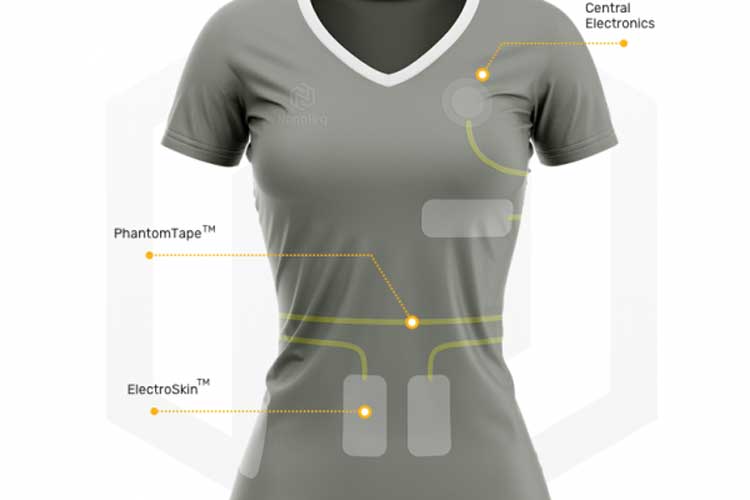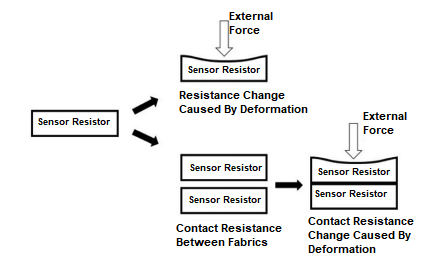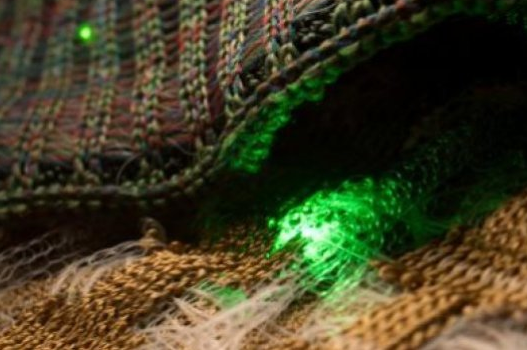MEMS Packaging Solder Paste:The Combination of Flexible Sensors and Clothing
MEMS Packaging Solder Paste:The Combination of Flexible Sensors and Clothing
Solder Paste and Ultra-Fine Solder Manufacturer-Shenzhen Fitech is a comprehensive solder paste supplier integrating production, sales, research, and service of solder paste, epoxy solder paste, and solder powder. Fitech is the leading unit for the formulation of solder powder standards of the Ministry of Industry and Information Technology. Fitech's products include ultra-fine lead-free printing solder paste, ultra-fine lead-free dispensing solder paste, ultra-fine lead-free jetting solder paste, ultra-fine lead-free pin transfer solder paste, no-clean solder paste, water-soluble solder paste, high-temperature solder paste, medium-temperature solder paste, low-temperature solder paste, etc. Fitech can manufacture electronic-grade packaging solder powders with particle sizes from T2-T10.

Introcution
Smart wearable devices have been widely used in medical, military, aerospace, and many other fields. With the continuous progress of smart textile technology, wearable devices have become a part of people's life. There is an opportunity for smart wearable development in sports assistance and health management. Due to the needs of human physiology and activities, smart wearable devices require stable monitoring and auxiliary functions and outstanding service performance.
As the core feature of smart wearable devices, flexibility is an important research topic of smart wearable devices. This paper focuses on the application of flexible fabric sensors in clothing and wearable devices, as well as the continuous improvement and innovation of flexible fabric sensors by global researchers. Textile clothing is the second skin of the human body.

The flexible fabric sensor is a type of flexible sensor based on textiles that are combined with sensing materials or elements in different ways to fulfill the needs of various wearable devices. On the basis of satisfying the physical and mechanical properties, the sensor maintains a smooth feel and flexibility of the fabric as well as even partially cleanable, making it more promising in clothing and wearable device markets.

IFitech
The Classification of Flexible Sensors
At present, flexible sensors are mainly divided into many categories, including flexible capacitive sensors, flexible piezoresistive sensors, flexible piezoelectric sensors, flexible inductance sensors, and flexible optical fiber sensors.
 1.1 Flexible Capacitive Sensors
1.1 Flexible Capacitive Sensors
Flexible capacitive sensors apply the principle of capacitors. The flexible capacitive sensor has an excellent linear response due to its high sensitivity to external forces and low energy consumption to detect small static forces.
The flexible capacitive sensor is made of flexible materials such as conductive film and fiber yarn. The gap is usually produced by elastic materials, flexible capacitive sensors, and clothing textiles. It is not only soft, comfortable, and curved but also can perceive the external environment changes with high sensitivity and spatial resolution.

 1.2 Flexible Piezoresistive Sensors
1.2 Flexible Piezoresistive Sensors
Piezoresistive sensors combine flexible materials and integrated circuits that can change the resistivity of material through stress. Output electrical signal changes in the measurement circuit can vibrate the corresponding stress data. Therefore, piezoresistive sensors are mainly used to measure physical quantities such as pressure and gravity. The sensor has the advantages of simple structure and high sensitivity, which is widely used in aerospace, navigation, biomedicine, and other fields.
The commonly-used materials are graphene polymers, carbon black polymers, semiconducting silicon, and germanium. SHIOEB proposed a polydimethylsiloxane (PDMS)/carbon nanofiber (CNF) nanocomposite with piezoresistive sensing ability. By dispersing CNFs into PDMS, the obtained nanocomposites have excellent electrical conductivity and low cost. It can be used to fabricate sensors with various shapes. XU et al. used low-pressure oxygen plasma treatment to decorate and activate polyurethane scaffolds to prepare polyurethane (PU)/carbon nanofiber (CNF)@carbon black (CB) conductive foams with high compression sensitivity, mechanical properties, and electrical conductivity, which can be used for the detection of micro-compression or micro-strain.

Figure 4. Mechanism of a resistive fabric pressure sensor.
 1.3 Flexible Piezoelectric Sensors
1.3 Flexible Piezoelectric Sensors
A piezoelectric sensor is made by applying the principle that piezoelectric material deforms after external action causes the electrode changes. The power changes can be obtained by measuring the changes in circuit output power. The sensor has the characteristics of a wide frequency band, high sensitivity, lightweight, simple structure, and stable performance. It is mainly used for pressure and acceleration testing in biomedicine, electro-acoustic, and other technical fields.

Figure 5. Principle of a piezoelectric sensor
Common piezoelectric materials include ceramics, quartz crystals, polyvinyl fluoride, nylon, etc. Some scholars have achieved high synergy between Fe3O4 nanoparticles and graphene oxide nanoplates by multi-step synthesis of ferric oxide (Fe3O4) or graphene oxide (GO). An all-fiber hybrid piezoelectric sensor is fabricated by using silk fibroin and polyvinylidene fluoride (PVDF) nanofibers.
 1.4 Flexible Inductive Sensors
1.4 Flexible Inductive Sensors
The inductive sensor is a device that applies the change of the coil self-inductance or mutual inductance to realize non-electrical measurement. It has a series of advantages such as simple structure, high sensitivity, high output power, low impedance, strong anti-interference ability, and high measurement accuracy.
The sensing coil of the sensor usually adopts conductive fiber. The conductive yarn is combined with the clothing to realize human breathing monitoring and motion capture.

 1.5 Flexible Optical Fiber Sensor
1.5 Flexible Optical Fiber Sensor
An optical fiber sensor is a kind of sensor made with the principle of the optical property change. It converts external physical quantities into optical signals through optical fiber for measurement. Optical fiber sensors have many excellent properties. It can replace people entering high-risk areas such as high-temperature and nuclear radiation areas for signal detection and can be used for receiving external information that people cannot sense.
In addition, optical fiber sensors have the advantages of high sensitivity, strong shape plasticity, and small size. Therefore, optical fibers can be used to measure physical quantities such as pressure and temperature in aerospace, military, communications, and other fields. Some scholars use polysiloxane urea copolymers to prepare thermoplastic silicon fibers, which have better elasticity than traditional optical fibers and are harmless to the original elasticity, softness, and comfort of textiles. Many other researchers prepared highly stretchable fibers composed of graphene nanosheets (GNPs) and polydimethylsiloxane (PDMS). This type of fiber has the advantages of low detection limit, fast response, and high repeatability.

Figure 7. Display of flexible optical fiber sensors
IFitech
Preparation Method
The flexible fabric sensor adopts different preparation methods by adding the sensing material to the textile structure. The sensor with high sensitivity converts the physical quantity into an electrical signal for measurement. Currently, the preparation processes of flexible fabric sensors include coating, weaving, and packaging.
 2.1 Coating
2.1 Coating
The coating method refers that metal particles, carbon-based materials, and polymer conductive composites being adhered to the fabric surface by deposition, printing, or collage to form a conductive coated fabric. It is currently the most common preparation method for flexible fabric sensors ( Table. 1). Deposition and printing are the mainstream coating methods.

Table 1. Different types of coating.
At present, the coating method is widely used in the preparation of various flexible devices, and the technology is relatively mature. The graphene oxide is attached to the surface of the silk fabric by vacuum filtration and then reduced to graphene by hot pressing to form a conductive coating.
Some conductive inks using dispenser printing methods directly print conductive coatings on the surface of polyester fabrics to form short-range capacitive flexible fabric sensors with proper measurement coefficients and measurement ranges. Some people spray graphite solution on polyester (PET) fabric to prepare capacitive flexible fabric pressure sensor electrodes. The addition of polystyrene sulfonate (PEDOT: PSS) can improve the fabric's electrical conductivity.
When fabricating flexible fabric sensors, the production process is relatively simple, and the reaction conditions are easy to control. There are more options and research topics for coating materials and attachment methods. Flexible fabric sensors prepared by the coating method usually have high sensitivity, good linearity, and a wide measurement range. However, due to the difficulties in controlling the uniformity of the deposition or printing process, the conductivity of the coatings can be influenced. Meanwhile, the issues of poor friction, cleaning ability, repeatability, and durability exist due to the adhesion strength between the conductive material and the fabric substrate. In addition, poor elongation and ductility of the coating reduce the fabric performance. Therefore, modifying conductive materials is a favorable direction to improve the durability and usability of flexible fabric sensors to enhance the adhesion to fabrics. Another idea is to change the distribution structure of conductive materials based on the fabric structure.

SAC Solder Paste SnBiAg Solder Paste SnBiAgSb Solder Paste SnBiAgX Solder Paste SnBi Solder Paste BiX Solder Paste AuSn Solder Paste SnSb Solder Paste SnPb Solder Paste Anisotropic Conductive Paste Flux for Ultra-Fine-Pitch Soldering

 2.2 Weave Method
2.2 Weave Method
Compared with the coating method, the weaving method is to directly weave conductive yarns to obtain conductive woven or knitted fabrics with sensing properties. Weaving methods for flexible fabric sensors require yarns with good electrical conductivity, low bending stiffness, uniform fineness and twist, and excellent strength, ductility, and softness. The extraordinary weaving depends on the selection or preparation of conductive yarns.

Figure 8. Display of a product using weave method.
Compared with the coating method, the weaving method is to directly weave conductive yarns to obtain conductive woven or knitted fabrics with sensing properties. Weaving methods for flexible fabric sensors require yarns with good electrical conductivity, low bending stiffness, uniform fineness and twist, and excellent strength, ductility, and softness. The extraordinary weaving depends on the selection or preparation of conductive yarns.
Currently, there are two methods for preparing conductive yarns.
The first method is to directly spin conductive fibers into yarns. Metal conductive fibers, carbon conductive fibers, and organic polymer conductive fibers are the popular materials used.
The second is to carry out a special treatment on the ordinary non-conductive yarns to realize certain conductive properties. The commonly used conductive yarns are coated with conductive yarns and composite spinning.
Flexible fabric sensors have excellent stretchability and ductility, which are used to fabricate strain sensors and piezoresistive pressure sensors.
By exploring and experimenting with the fabrication process of conductive yarns, scholars can improve the sensing and usability of flexible fabric sensors. Some scholars use the silver-rich composite structure, adding silver nanoparticles to elastic fibers of multifilament mechanism and then injecting silver ions to weave strain fabric sensors. This type of sensor has high stretchability and sensitivity.

Figure 9. US scientists directly weaved light-emitting diodes and sensors into textile polymer fibers.
There are still some problems in the weaving method of flexible fabric sensors. For example, the weaving process is cumbersome, and the cost of production time is high. The strength of the conductive yarn is low. The bending stiffness is large. Moreover, the sensor is easily broken or damaged during the weaving process. The downsides affect the sensing performance of the fabric sensor. Sensor components require process designs to ensure high integrity. Relative slippage between the yarns also affects the accuracy of the fabric sensor.
However, the flexible fabric sensor fabricated by the weaving method has high sensitivity and linearity. At the same time, it is closer to the feel, comfort, good durability, water resistance, and other service properties of clothing because of the retention of the fabric structure. It is a better choice for flexible fabric sensors for smart clothing, such as human monitoring. Therefore, the important direction of studying the weaving method to fabricate flexible fabric sensors is to simplify the weaving process, modify the conductive fibers, and improve the textile performance.
 2.3 Packaging Method
2.3 Packaging Method
The earliest application of packaging methods to the integration of sensors and wearable devices is to assemble sensors to smart clothing or devices by stitching or embedding. The production of flexible fabric sensors requires flexible conductive films or conductive nanowires for the fabric structure. As a result, the flexible sensors have a fabric basis.

Figure 10. Schematic diagram of smart clothing embedding.
The packaging method of flexible fabric sensors mainly considers the selection of flexible conductive material and the design of fabric structure. The integration method is relatively simple, but there are some problems. Since the sensor and the fabric are independent of each other, the conductive material and fabric structure are still backward, affecting the measurement accuracy of the fabric sensor. The stretch and flexibility of the sensor components are limited, so the performance and comfort of the fabric sensor defect.

Figure 11. Schematic diagram of the internal structure of the sensor and its attachment to the fabric.
However, the method of directly integrating flexible sensor devices into fabrics can simplify the production steps, which is currently the most achievable fabrication method for the mass production of flexible fabric sensors. It has advantages in the production of comprehensive knitted surveillance garments or wearable devices. Hence, this method can optimize the packaging structure and reduce the sensor slippage that may be caused by human activities, improving the measurement accuracy and ensuring good stability and repeatability. It is the optimal direction for the preparation of flexible fabric sensors.
IFitech
The Pros and Cons of Flexible Sensors in Smart Clothing
 3.1 The Pros of Flexible Sensors
3.1 The Pros of Flexible Sensors
Flexible sensors can detect the physical condition of the human body in any environment, at any time, and in any state. Compared with traditional detection methods, flexible sensors are less restricted by objective factors.
Flexible pressure sensors have advantages in smart clothing that detects the state of human motion. It can detect the strength of human muscles and keenly capture its changes according to the muscle stretching and different stress points when people are exercising. It can be used as a test suit for professional sports training, adjusting unscientific sports patterns, improving the level of sports function, and effectively guiding the continuous improvement of sportswear design. Flexible humidity sensors can detect human sweat. Since sweat can reflect the health of the elderly, this sensor can detect the wearer's health data in time. Flexible pressure sensors are mainly used in elderly smart clothing and medical clothing.

Figure 12. Schematic diagram of smart sportswear.
Flexible temperature sensors have advantages in smart clothing with low sensing ability, which are suitable for children's clothing. Once the child's body temperature is abnormal, the sensor will detect the body information. The sensor transmits the information to the parent's mobile phones or computer terminal devices so that child can seek medical treatment in time. Flexible odor sensors have attractive advantages in smart clothing for detecting external hazardous gases, which can respond to harmful substances, ethanol, and other gases rap

Figure 13. Schematic diagram of children's smart clothing.
 3.2 Limitations and Improvements of Flexible Sensors in Smart Clothing
3.2 Limitations and Improvements of Flexible Sensors in Smart Clothing
Compared with functional clothing products, the application cost of flexible sensors in smart clothing is higher. The mismatch between the social infrastructure and the development pace of flexible sensors is the reason for the high costs that keep them in experimental products. Compared with hardware sensors, the accuracy of data collected by flexible sensors is relatively poor. Flexible sensors need to be worn tightly to ensure data collection accuracy. If the sensor is far from the individual, the data reliability and sensor functionality degrade. Unlike traditional clothing fabrics, flexible sensors are less comfortable. Besides, thin-film materials for flexible sensors are still different from truly soft clothing fabrics. The above points are limitations that cannot be ignored in its development process.

Figure 14. Schematic diagram of smart clothing art.
In order to enter the market, mass production is the key to reducing costs. Due to the lack of flexible sensor prices, the use of cheap new materials, simple processing technology, and mature production technology can effectively reduce costs. The investment in early trials should not be underestimated. If the project is technically mature in a social environment, the sensor cost will be lower. As the lack of comfort with flexible sensors, trials of new fabrics should be conducted. New composite fabrics are the development target of flexible sensors because they improve the flexible distribution density to meet density requirements. The new composite fabrics have a certain tightness, limiting the interference of external factors and ensuring a high smart clothing sensitivity.

FIgure 15. Smart fabric schematic.
 3.3 Development Prospects of Flexible Sensors in Smart Clothing Applications
3.3 Development Prospects of Flexible Sensors in Smart Clothing Applications
In special occupations, smart clothing has a good development prospect, and the application of various flexible sensors in smart clothing will create great practical benefits. For smart clothing worn by workers in desert environments, temperature and humidity sensors can detect the living characteristics of the workers and monitor the harsh external environment, which is helpful for the workers to keep track of their health and environmental conditions at any time. During this process, personnel information is synchronized with the network. When people are in danger, it is conducive to rescue and effectively reducing the casualties. For polar workers, temperature and pressure sensors can detect the temperature conditions and life characteristics. Once there is an abnormality in the polar staff or explorers, the sensors will perceive quickly and then transmit the health information and coordinate position to the rescue team. Hence, the rescue time can be shortened.

Figrue 16. Schematic diagram of polar clothing.
Conclusion
The application of flexible sensors in smart clothing allows the wearer to understand their physical condition anytime, anywhere, and the sensor development adapts to the social development trend. From technology appearance to maturity, the speed cycle of technology is getting shorter and shorter exponentially.
Source:传感器专家网, retrieved by Shenzhen Fitech


















 Back to list
Back to list



